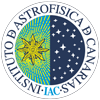At the frontiers of the Universe: lensing clusters for unveiling the most distant and young galaxies
17/12/2014
Researchers from the IAC and the ULL are part of the international team that discovered four of the most distant galaxies known to date, analyzing deep images of a galaxy cluster that amplifies their light

Earlier this year, a team of researchers led by astronomers from the Instituto de Astrofísica de Canarias (IAC) and the University of La Laguna (ULL) published the discovery of one of the most distant galaxies observed to date (see the related press release), analyzing the first images of the "HST Frontier Fields" (HFF) program for the cluster Abell 2744. Now, the same team has completed the first analysis of HST data for MACSJ0416.1-2403, the second cluster in this ambitious program, only two months after they were published. The analysis revealed four galaxies at similar distances to the first one, making an important contribution to our knowledge of the properties of galaxies in the early universe.
Galaxy clusters, given its large gravity, act as huge lenses bending and amplifying the light of background sources, including very faint galaxies to the edge of the observable universe. Since 2013, in the framework of the HFF program, three of the most powerful space telescopes to date - Hubble, Spitzer and Chandra - take deep images of six clusters of galaxies in order to exploit the gravitational lensing they produce to detect and study, for the first time, the fainter and smaller galaxies in the first billion years of the Universe.
The data for the first cluster Abell 2744 clearly showed the potential of the HFF project in the detection of the most distant galaxies. Indeed, the first published result for this field was the analysis of Abell2744_Y1 (Laporte et al. 2014), one of the brightest galaxies discovered at redshift z ~ 8, i.e., the time when our Universe was only about 650 million years old. The same team that discovered Abell2744_Y1 now presents the detection of four new galaxies at similar distances in the second Frontier Field MACSJ0416-2403. Alina Streblyanska and Ismael Perez-Fournon, both scientists from the IAC and ULL, are among the authors involved in this study.
“The innovation in the current analysis of MACSJ0416-2403, in comparison with other studies including our own work with Abell 2744, is the combination of deep space images from the HST and Spitzer telescopes with the high-quality ground-based near-infrared image obtained at the VLT” - explains Alina Streblyanska, Severo Ochoa Fellow at IAC and second author of the article. “Only thanks to this unique combination we were able to identify real galaxies at z~8 and discard possible interlopers at much lower distances. All four new galaxies are more distant than Abell2744_Y1, and this means that once again we have pushed the limit of how far into the Universe we can look. "
Nicolas Laporte, first author of the article, notes that thanks to these new results we are greatly improving our knowledge about the first galaxies in the Universe. “For example, it seems that the first galaxies were much more star-forming objects than our own galaxy (producing 10 times more stars), but also much smaller than the Milky Way (30-50 times.
These results show once again the exceptional potential of the HFF program in the detection and analysis of the most distant galaxies known to date. The article will be published in February the journal "Astronomy & Astrophysics" and with the image as a cover page of this edition.
Publications:
"Frontier Fields : Combining HST, VLT and Spitzer data to explore the z~8 Universe behind the lensing cluster MACS0416-2403" Laporte, N. et al. 2015, A&A accepted
Link: http://arxiv.org/abs/1412.1089
"The first Frontier Fields cluster: 4.5 micron excess in a z ~ 8 galaxy candidate in Abell 2744" Laporte, N. et al. 2014, A&A, 562, L8
Image credits: ESA/Hubble, NASA, HST Frontier Fields and Alina Streblyanska. Laporte, N. et al. 2015, A&A accepted.
Acknowledgement: Mathilde Jauzac (Durham University, UK and Astrophysics & Cosmology Research Unit, South Africa) and Jean-Paul Kneib (École Polytechnique Fédérale de Lausanne, Switzerland)


